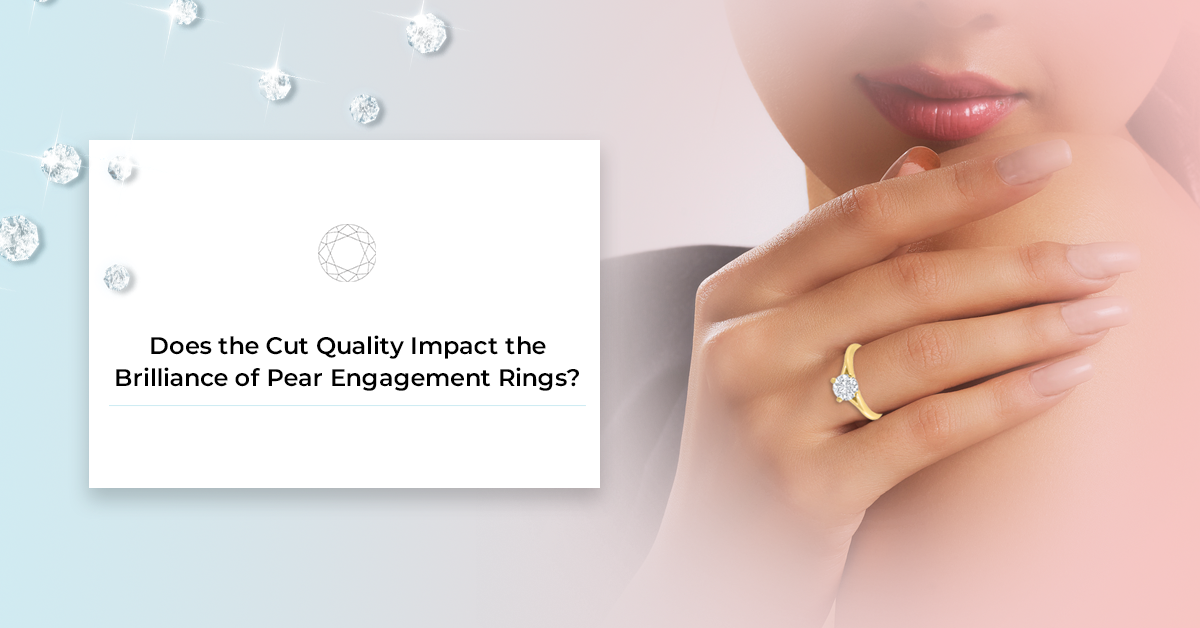
Engagement rings speak volumes about the promise of a bond that tends to last forever. Diamond engagement rings stand out for their mesmerizing sparkle in this age-old tradition. We often are very particular in choosing the color, type, luminance, or carat of the diamond used in the ring. But– Do we know the importance of the shape and how far it can impact the overall brilliance of gemstones?
Whether your diamond is round, heart, oval, marquise, or pear, the cut quality is what makes a diamond shine the way it does. Diamond cuts require precise artistry and workmanship for proportions, symmetry, and polish to deliver a magnificent light return.
Pear shaped engagement rings have a unique fan base. The pear-shaped diamonds that embellish pear diamond engagement rings symbolize tears of joy, liaison, and love for your mate. This is the reason why they are commonly associated with love and weddings. But little do you know how much effort it takes to bring that perfect pear of brilliance to life! Let’s discover the impact of cut quality on the brilliance of pear diamond engagement rings.

Gemstones are purchased for their aesthetic appeal. Good cutting is one of the deciding factors in the appearance of a gemstone. Through skillful cutting, a basic colored stone can become a genuine gem.
Sometimes, gemstones have a bright outer ring and a lighter center due to shallow cut facets, resulting in a dead spot in the middle that appears like a window or fish eye. Poor cuts make the gemstones appear dull, and you can see right through them.
You may apply this test before you buy any gemstone!

The cut serves to showcase the gem’s natural brilliance to the maximum possible extent. There are five major factors for the evaluation of cut:
The girdle outline of a gem is a crucial aspect of its shape, often resembling the original rough shape of the rough gem. Market demand and cutting yields lead to certain shapes being more expensive based on their ability to maintain weight retention.
It is also called a facet pattern. Cutting styles contribute to a gem’s optical performance in specific ways by enhancing its brilliance and producing lovely patterns. For example, the market standard for rubies and sapphires is mixed cut, but the standard for emeralds is step cut.
The faceted cuts in gems maximize brilliance and scintillation, with a crown and pavilion responsible for light capture and brilliance. Proper proportions, such as shallow or deep pavilions, are influenced by the rough material’s shape. Depth percentage and length-to-width ratio are used to measure gem proportions, with depth percentage typically ranging from 60-80% and length-to-width ratio indicating desirable shapes for non-round stones.
Well-cut gems show attention to detail. In the absence of this, defects like asymmetrical girdle outline, off-center culet, off-center table facet, narrow/wide shoulders, thick girdle, poor crown alignment, or a wavy girdle may occur.
When not enough care is taken while finishing, some problems like facet disconnection, misshaped facets, rounded facet junctions, or poor polish arise. These issues can be corrected via repolishing.

Brilliance, Fire, and Scintillation of diamonds are three lesser-known attributes that contribute to a diamond’s beauty.
Al Gilbertson, GIA project manager of International Diamond Grading System, clarifies the importance of brilliance, fire, and scintillation in a diamond’s face-up appearance, talking about its look when set in an engagement ring.

It is very important to have proper vigilance when one decides to purchase a pear shaped diamond engagement ring. The following tips are worth considering before taking the step:
Consider symmetry: Make sure the point of the diamond aligns with the center of the rounded end to check for symmetry. A diamond with balanced symmetry has a more appealing appearance.
Now, you know that the cut quality greatly impacts the brilliance, fire, and scintillation of diamonds or gemstones. All sorts of diamond shapes, including that of pear engagement rings, greatly depend on the cut grade, which affects its overall beauty and value. Get unique pear shaped engagement rings from the exquisite online store La Joya.
The pavilion depth is the distance measured from the culet (small flat facet at the bottom) to the bottom of the girdle. Light will seep out of the bottom or escape from the edge of the stone if the pavilion is too shallow or deep. More light will enter the crown through a well-cut diamond. So, pavilion depth affects the cut of pear cut engagement rings.
Yes, they do appear huge. It is because of their elongated shape. Not only do they look bigger, but their top surface is actually 8% larger! This implies that a diamond of any size will have a significant effect due to its bigger size and appearance.
Yes, compared to round diamonds of the same carat weight, pear-shaped diamonds can cost between 10% and 30% less.
Yes, it is. Gold looks good with warmer tones of pear shaped engagement rings, such as shades of red or yellow, etc.
Pear-cut diamonds are not graded for cutting by certification organizations such as the GIA. It is just not possible to create a sound-cut grading system for pear-cut diamonds due to the abundance of variations and varying ratios and proportions. Therefore, if you are into buying some unique pear shaped engagement rings, use your eyes to decide whether to pick or pass.
Shop by metal
Shop by diamond
@ All rights reserved La Joya Jewelry Inc